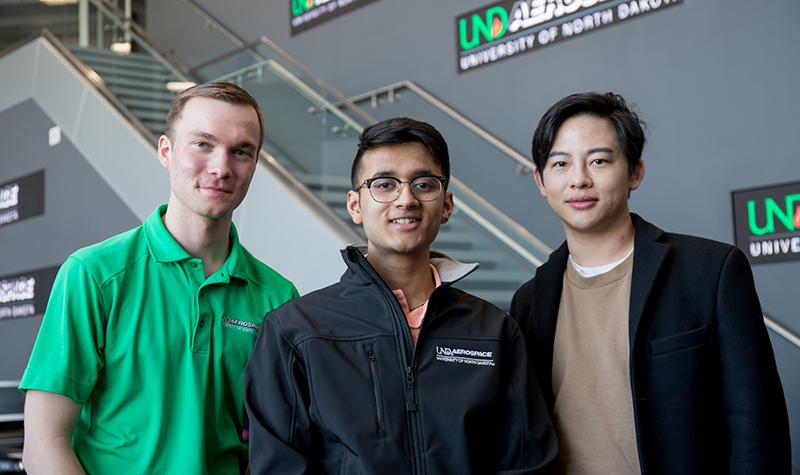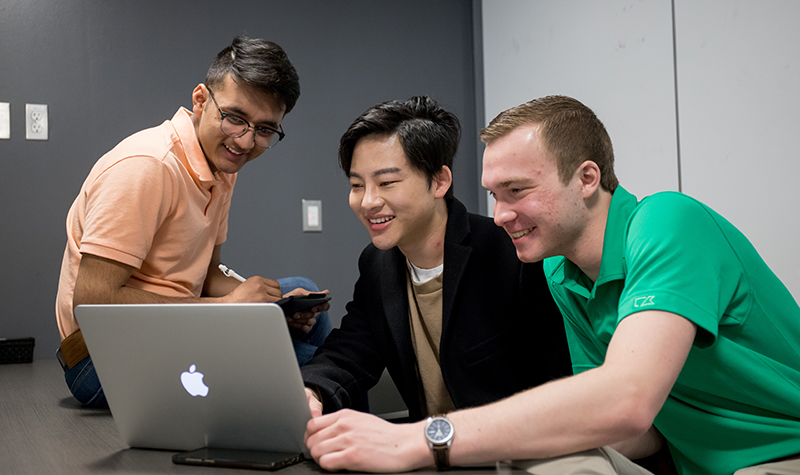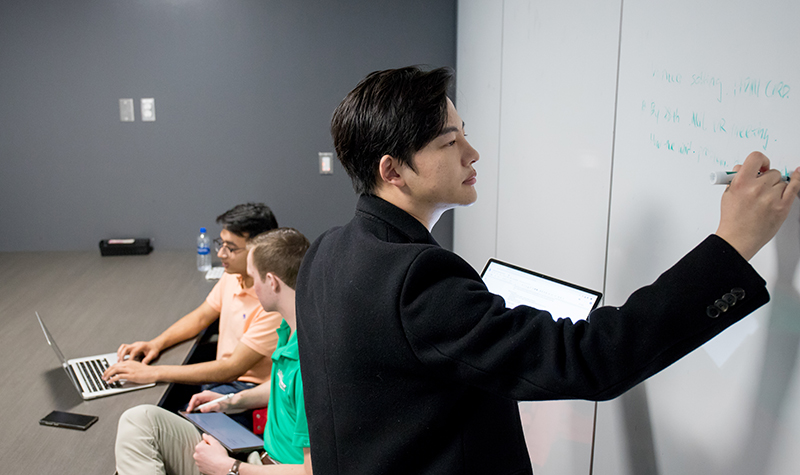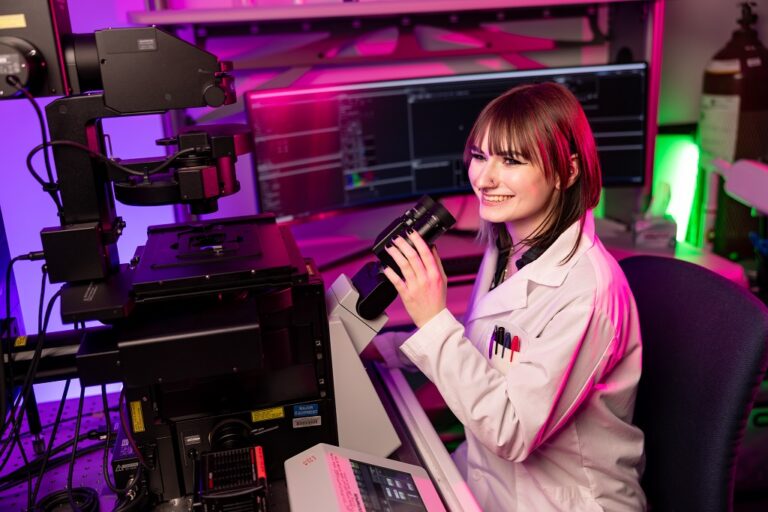Freshman trio wants to make airline-luggage tracking a ‘flash’
Concept for modern baggage tag makes UND freshmen finalists in FAA Smart Airport Design Challenge

Three UND freshmen have developed a concept that could very well be the next big thing in air travel.
Their idea placed them among the top three teams in the nation for the Federal Aviation Administration’s (FAA) Smart Airport Student Design Competition.
In May, commercial aviation majors Harley Jiang, John Dulski and Mihir Patel will travel to Atlantic City, N.J., to participate in the 2020 FAA Challenge Forum, representing the final stage of competition and the chance to win $25,000.
There, they’ll present FlashTag: the innovative baggage tag they’ve been conceptualizing since September.
Prompted by the Smart Airport Challenge to focus on improving the efficiency and effectiveness of the airport environment and travelling experience, the trio zeroed in on a problem as old as air travel itself: lost luggage.
“The fundamental idea was to take something that travelers use every day and make it more modern,” said Jiang. “We also wanted to create a product that could act as a traveling assistant.”
Digital age convenience
Essentially, FlashTag pairs your luggage with what are already peoples’ everyday assistants: their smartphones.
Team advisor Kim Kenville, professor of aviation in the John D. Odegard School of Aerospace Sciences, said FlashTag provides a way to track your baggage in real time. She talked about her recent air travel to highlight the concept.
With an hour layover in Minneapolis between connecting flights, there was a possibility that her bag wouldn’t make the connection. Current technology — paper bag tags — would leave her guessing until she got to her final destination and ventured down to baggage claim.
“It would have been great to know if my bag wasn’t going to make the connection,” she said. “I would just get off the plane and go home. The airline would be able to know where I live and deliver it to me.”
It would be FlashTag and its accompanying smartphone application that would alert Kenville, as well as the airline, about her missing luggage. The smart tag would help her avoid the stress and hassle of standing in line and filling out forms to retrieve her belongings.
“The next generation of travelers is going to want something like this, because our phones already tell us if our flight’s on time,” Kenville said. “I can track flights across the country. I can listen to air traffic. Why can’t I know where my bag is?”

Efficient and appealing airports
Dulski, who was approached by Jiang about participating in the competition, thought about physical infrastructure first — layouts and aesthetics that could make airports better. He quickly realized such ideas opposed the spirit of the competition, given that physical changes are not only costly and require extensive planning, but also disrupt already busy terminals.
“Our main goal then became to use what we have right now to make a much more efficient and appealing airport experience,” Dulski explained. “FlashTag can be very cheap to produce as opposed to the concrete slabs of a construction project.”
Overall, less stress means more revenue for all parties involved. FlashTag’s proposal appealed to the FAA because it carefully analyzed the economics of the product. Kenville said that when people aren’t as obsessed about their travel logistics, they’re more likely to spend money at shops and restaurants around the terminal — the primary money-makers for airports.
FlashTag could also lead to a more hands-off approach to baggage handling, said Jiang, which could increase airline revenues. In America especially, a significant workforce is dedicated to taking luggage from passengers, weighing and tagging it, then placing it on a conveyor belt to eventually transfer to the aircraft.
“If we can reduce that, we may not have to worry as much about workforce shortages in other areas, such as loading baggage onto aircraft,” Dulski said.

Recipe for success
Though all three group members are academic freshman, Jiang came to UND from Los Angeles with an associate’s degree in fashion. When he saw an email solicitation sent throughout UND Aerospace for what was more or less a design challenge, he was immediately interested.
“I, being on the creative side, don’t have the technical knowledge,” said Jiang before gesturing to his project partners. “Mihir [Patel] is the one who has the technical background and John [Dulski] has well-rounded thoughts on many issues.
“We’ve been able to support each other, and now we’ve made it to the finals.”
Patel has been the brains behind what would make FlashTag tick. As the team members prepare for their final presentation in May, they are working on innovative ways to present the concept while simultaneously working with a tight budget.
“There are technologies like [near-field communication] chips involved that I had some knowledge in, and I’ve been doing research around it because that’s my interest, as opposed to the creative stuff,” said Patel, referring to the tech that allows FlashTag to transmit location data.
The judging panel for the Smart Airport Challenge, in their written feedback for the project, praised the engineering aspects of the proposal in particular, saying that the team’s work demonstrated careful consideration of important design and implementation details. The proposal’s risk analyses and patent searches also demonstrated the team’s considerations of the pros and cons of the idea.
Trending toward tech
In May, at the FAA Challenge Forum, UND’s FlashTag will be going up against projects from Purdue University and University of Texas at Arlington. Kenville, who’s planning to be there with the team, said UND made the finals in the first year it ever participated in the FAA Challenge. Typically, she said, the annual challenges have a focus on airport engineering. UND is unique among aviation programs in that it’s not tied directly to an engineering college.
With the FAA Challenge shifting to technology, that could certainly spell more UND participants in the future, but Kenville has been impressed by this group’s ability to take the reins and become legitimate contenders. She has provided useful commentary and direction for the group, but maintains that, otherwise, she’s been hands-off.
“They’re a freshman group,” Kenville said. “Coming to college and being immersed in aviation — our program can be stressful for a new student. They have all the stresses a normal freshman would face, then they take this on. It’s impressive to see that commitment.”



